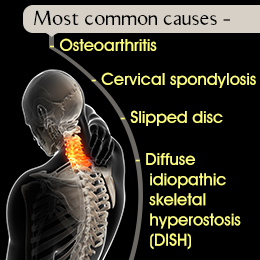Formation of a bone spur in the neck is a painful condition that can adversely affect your ability to perform routine activities. The following write-up provides information on the causes, symptoms and treatment of this condition.

The other name of bone spur is
osteophyte. This can be described as an extended bony growth on the normal bone structure. It may form in any part of the body, but is most commonly found in the neck, shoulders, feet, knees, and fingers. Bone spurs in the neck are also known as cervical bone spurs. The cervical spine tends to suffer damage when it is subjected to a lot of pressure, friction, or stress for a long period of time. Bone spurs are formed as the body tries to repair these damages by building some extra bone.
Causes
The most prevalent cause of cervical bone spurs is aging. As we grow old, the sac-like cartilaginous discs that are present in between the bones of the cervical spine, wear out. Moreover, the fibrous tissues of the ligaments that hold the bones of the cervical spine also break down with age. In this condition, your body creates the extra bone in order to maintain the stability of the joint. There are various health disorders that can be responsible for this kind of degeneration of the neck bone. These include:
- Cervical spondylosis
- Herniated disc or slipped disc
- Osteoarthritis
- Diffuse idiopathic skeletal hyperostosis (DISH)
Other risk factors include structural problems of the neck bones that may arise due to:
- Birth defect
- Injury
- Poor posture
- Obesity
- Malnutrition
Symptoms
» In the beginning, bone spur may not be symptomatic. Symptoms appear when the size of the bone spur increases, thereby compressing the bones, ligaments or tendons in the surrounding areas.
» The affected individual is likely to experience a dull pain in the neck and shoulder that worsens with activities and subsides with rest. Sometimes, the pain extends down to the lower back region.
» As the bony projection rubs against the soft tissues of tendons and ligaments repeatedly, inflammation occurs in them and tenderness can be felt in the neck area.
» If the bone spurs affect the nearby nerves, patients experience symptoms like numbness and tingling in the hands. It can lead to loss of coordination in certain parts of the body.
Treatment
There are two different forms of treatment for neck bone spurs. One is the nonsurgical method; and the other one is surgery. First of all, presence of a bony overgrowth is detected with the help of X-ray, MRI scan and CT scan.
» To bring down the pain and inflammation, doctors prescribe non-steroidal anti-inflammatory medicines and muscle relaxants.
» If the pain doesn't resolve, then corticosteroid injections are administered.
» You can apply ice pack on the neck area to reduce the pain.
» Physical therapy is recommended for some patients. It helps to strengthen the weak neck muscles. Mild exercises like water aerobic exercises, have proved to be highly beneficial for many patients.
» Doctors also suggest modifications in activities in order to minimize the pressure from neck and shoulders.
» In cases where non-surgical treatments do not give the desired results, surgery may be recommended for the treatment of cervical osteophyte. The choice of the surgical method depends on the location of the bone spur and the overall health condition of the patient. After the surgery is successfully done, one can get relief from the symptoms and lead a good quality life.
If you have bone spurs in your neck, there is no need to panic. You may not even need any treatment for it as long as it is not giving you any sort of trouble with its symptoms. Once the symptoms show up, consult your doctor and start the treatment on time. Follow the instructions given by your doctor carefully and maintain a healthy lifestyle. Thus you will be able to lead a fruitful and happy life.
Disclaimer:
The information provided in this article is solely for educating the reader. It is not intended to be a substitute for the advice of a medical expert.


 The other name of bone spur is osteophyte. This can be described as an extended bony growth on the normal bone structure. It may form in any part of the body, but is most commonly found in the neck, shoulders, feet, knees, and fingers. Bone spurs in the neck are also known as cervical bone spurs. The cervical spine tends to suffer damage when it is subjected to a lot of pressure, friction, or stress for a long period of time. Bone spurs are formed as the body tries to repair these damages by building some extra bone.
The other name of bone spur is osteophyte. This can be described as an extended bony growth on the normal bone structure. It may form in any part of the body, but is most commonly found in the neck, shoulders, feet, knees, and fingers. Bone spurs in the neck are also known as cervical bone spurs. The cervical spine tends to suffer damage when it is subjected to a lot of pressure, friction, or stress for a long period of time. Bone spurs are formed as the body tries to repair these damages by building some extra bone.